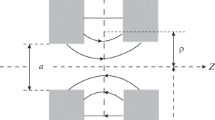Abstract
The main feature of the examined cyclic induction accelerator is the separation of control and accelerating electromagnetic fluxes. The control magnetic field is formed by analogy with the magnetic field of a weakly focusing synchrotron, and the accelerating vortex electric field is generated by electromagnetic cores – inductors. Such a design of the cyclic induction accelerator allows the active steel volume and the power of a supply unit to be reduced significantly, and the separation of control and accelerating magnetic fluxes allows the energy lost by particles by synchrotron emission to be compensated using a relatively simple method. Recent investigations have demonstrated that in this accelerator, electrons can be accelerated to energies exceeding 300 MeV.
Similar content being viewed by others
REFERENCES
V. A. Moskalev, Betatrons [in Russian], Energoatomizdat, Moscow (1981).
D. Kerst et al., Phys. Rev., 78, 297–303 (1950).
C. A. Kapetanakos, L. K. Len, T. Smith, et al., Phys. Fluids, 3, No. 8, 2396–2402 (1991).
C. A. Kapetanakos, D. Dialetis, S. J. Marsh, et al., Phys. Rev., 44, No. 6, 3900–3907 (1991).
D. L. Ivanenko and I. I. Pomeranchuk, Dokl. Akad. Nauk SSSR, 44, 343–348 (1944).
M. S. Khvastunov, Prib. Tekh. Eksp., No. 3, 20–23 (1981).
V. N. Kanynnikov, P. S. Mikhalev, N. F. Simukhin, et al., in: Proc. of the 6th All-Union Conf. on Accelerators of Charged Particles, Vol. 2 [in Russian], Dubna (1979), p. 319.
L. M. Anan'ev, A. A. Vorob'ev, and V. I. Gorbunov, An Induction Electron Accelerator [in Russian], Atomizdat, Moscow (1961).
M. F. Filippov, Handbook on the Calculation of a Betatron Electromagnet [in Russian], Publishing House of Tomsk State University, Tomsk (1967).
A. Azimov, R. D. Babadzhanov, V. A. Moskalev, et al., Prikl. Yad. Spektrosk., No. 8 (1979).
É. G. Furman, A betatron with Magnetization [in Russian], Publishing House of Tomsk Polytechnic University, Tomsk (2000).
V. A. Kas'yanov, M. V. Rychkov, A. A. Filimonov, et al., in: Collection of Reports at the 10th Int. Conf. on the Application of Particle Accelerators to Industry and Medicine [in Russian], Moscow (2001), pp. 113–116.
V. P. Sarantsev and Z. A. Perel'shtein, Collective Acceleration of Ions in Electron Rings [in Russian], Atomizdat, Moscow (1979). 277
J. Livingood, Principles of Cyclic Particle Accelerators [Russian translation], Inostrannaya Literatura, Moscow (1963).
A. A. Vorob'ev, B. A. Kononov, and V. V. Evstigneev, Electron Beams of Betatrons [in Russian], Atomizdat, Moscow (1974).
V. A. Moskalev and V. G. Shestakov, in: Trudy Nauchn, Issled. Inst. Yad. Fiz., No. 1, 5 (1971).
17. V. G. Shestakov, Candidate's Dissertation in Technical Sciences, Tomsk (1969).
18. V. A. Moskalev, Patent of the Russian Federation No. 2153783, Bull. No. 21 (2000).
Author information
Authors and Affiliations
Rights and permissions
About this article
Cite this article
Moskalev, V.A., Sergeev, G.I. A Cyclic Induction Accelerator. Russian Physics Journal 46, 270–277 (2003). https://doi.org/10.1023/A:1025485711315
Issue Date:
DOI: https://doi.org/10.1023/A:1025485711315



